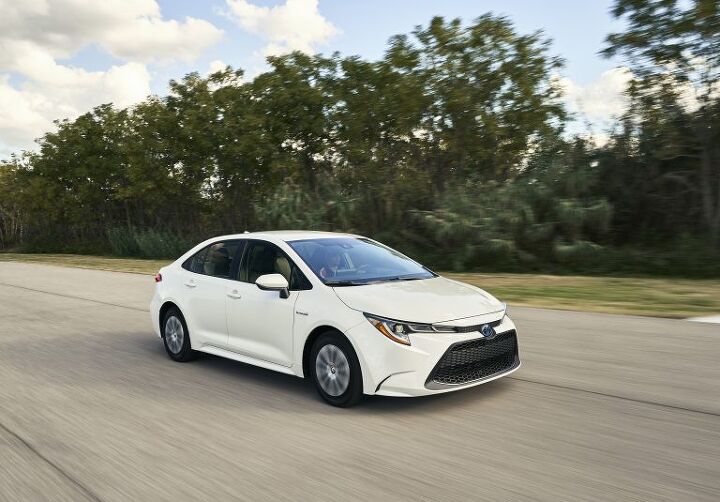An AWD Hybrid Corolla Could Happen, but What Becomes of Toyota's C-HR?

Jack Hollis, Toyota North America’s general manager, was quite forthcoming during a roundtable discussion at the L.A. Auto Show. After unveiling the brand’s upcoming all-wheel drive Toyota Prius and hybrid Corolla sedan, he speculated on what else might be coming down the product pipe.
We already know that Toyota wants to TRD-ify as many models as possible (the Camry and Avalon aren’t an end point, apparently), but AWD and hybrid power serve the purposes of practicality, not style. There’s more reason to desire a vehicle that sips gas or blasts through snowbanks with aplomb.
That’s why an AWD, hybrid Corolla isn’t off the table. Upon hearing this, this writer’s mind drifted to the new-for-2019 Corolla Hatch and a small crossover that, strangely, isn’t offered with AWD. What would a would-be C-HR buyer be giving up if Toyota went ahead and electrified the rear axle of the Corolla Hatch?
Not much at all, it turns out. This gets us, unfortunately, into the ongoing discussion of “what makes a crossover?” Where does a hatchback end and a crossover start? We’ll let you mull that over.
As reported by AutoGuide, Hollis wants the brand’s small cars to be everything to everyone. Not a bad strategy, especially given that its domestic rivals are bolting for the exit.
“There’s no doubt that it is [being considered],” Hollis said of the AWD, electrified Corolla. “You’ve heard from Akio Toyota, our CEO, who has said his desire was to offer every one of our cars with a hybrid option. Or an electrification option is really what I should say. Because it can be different technologies. We’re not ready to make a comment about AWD (Corolla), but the AWD systems that are interchangeable, and or growth in AWD, is something we know is something that the US consumer has asked for, it’d be silly not to deliver on that.”
In this case, like the Prius AWD-e, the rear axle of the Corolla would be motivated by an electric motor, eliminating the need to send a driveshaft aft from the transaxle. Since driving the thing back in April, I’ve pondered improvements to the competent little five-door. Yes, the Subaru Crosstrek was part of these thoughts. While Hollis may have only had the sedan version in mind, I’m thinking hatch here.
Let’s say Toyota pulls the trigger on the idea:
The Corolla Hatch, which was the first small Toyota car to adopt the TNGA platform when it went on sale last summer (the sedan shows up next year with the same bones), stretches 172 inches in length. The C-HR spans 171 inches stem to stern. The Corolla Hatch is two-tenths of an inch slimmer, and both vehicles share an identical wheelbase of 103.9 inches.
So, nearly identical footprints. But the C-HR is a crossover, you say, assuming the lack of AWD doesn’t catapult the model from that segment in your mind. It’s got room for life. Well, that depends on how much living you’ve been up to.
It’s true that the C-HR stands 4.5 inches taller than the Corolla hatch, and that extra ceiling height gives it an interior volume of 102.8 cubic feet — 18 more than the Corolla Hatch’s 84.6 cubes. In practical terms, however, there’s not much more cargo room. Such is the life of a subcompact crossover. I’ve told you about my friend who’s selling her CX-3 because her baby won’t fit in the rear seat, right? Behind the rear seats, one will find 19 cubic feet of cargo volume, which is less than four cubes more than the trunk of my Cruze. Behind the Corolla Hatch’s rear chairs, there’s a paltry… 17.8 cubic feet.
Fold down the rear bench in the hatch and 23.3 cubic feet open up. Because of that ceiling, the C-HR affords more cargo area — 36.4 cubic feet of it. Still, this is only useful if your passengers count numbers less than two.
Still, as a crossover (or faux crossover), the C-HR can at least handle the rugged stuff, right? That depends on where you place the starting point of “rugged.” The C-HR’s ground clearance is 5.9 inches. The Corolla Hatch? 5.1 inches. You might make it 50 yards further down the trail. (The Crosstrek’s underbody towers 8.7 inches above the earth’s surface)
Also in the hatch’s court is a 2.0-liter engine boasting 168 horsepower and 151 lb-ft of torque, hooked to an available CVT with a physical launch gear. The C-HR, making do with 144 hp and 139 lb-ft and carrying an extra 240 pounds, has no such trick tranny.
Given the hatch’s attributes, one wonders if Toyota will hold off on AWD-ifying the model — or at least forgo applying four-wheel traction to the five-door variant. Would such an addition end up cannibalizing C-HR sales? After all, raise this hypothetical electrified hatch eight-tenths of an inch, and it becomes more of a crossover than the C-HR (which sold 45,345 units in the first 11 months of 2018).
Anyway, this little bit of thinking is either an indictment of the C-HR or an appeal to the buying masses to give hatchbacks with lower starting prices a chance. We’ll see what Toyota decides.
[Images: Toyota, Chris Tonn/TTAC, Steph Willems/TTAC]

More by Steph Willems
Latest Car Reviews
Read moreLatest Product Reviews
Read moreRecent Comments
- Dave M. My hipster daughter is greatly into it. We watched the race together this weekend. It was interesting but I'm not devoted to it like she is. She'll be at the Austin race in October.
- Bd2 If I had time to watch other people driving, then I would go for LMP.
- Steve Biro There are 24 races on this year’s F1 schedule. And I guarantee you no more than two will be reasonably exciting, Meanwhile, F1’s reception for Andretti reveals the dark underbelly of the sport. I have followed F1 since the 1960s and, frankly, I am running out of interest. I’ll catch a race if it’s convenient but won’t bother DVRing them.
- YellowDuck Been watching since the 80s, seriously since the 90s once we had reliable TV coverage. I'm in Canada though. Hey, and don't forget that the Interlagos race is also in a convenient time zone, as is Mexico. So that's 5 races in the Americas. Absolutely love it, but it takes a bit more interest in the technical / strategic side of things to really appreciate it. It's not just going fast in circles until someone crashes into someone else, while drunk people watch. The US can be proud of what it has contributed - Austin is one of the best tracks on the calendar, Vegas turned out to be much better than anyone could have hoped, and even Miami - a real Indy car-style track - produced a good race this year.
- JMII I watch every F1 race, same with Indycar which is 100X better in terms of actual racing.





































Comments
Join the conversation
Man those are some ugly wheelcovers on the Corolla Hybrid.
Slap the Celica name on it and resurrect the old homoligation specials. Maybe no one will notice the 4 doors.